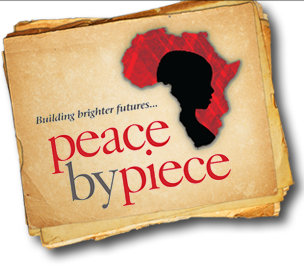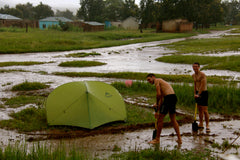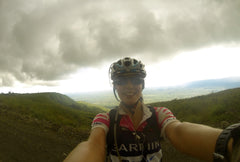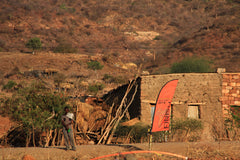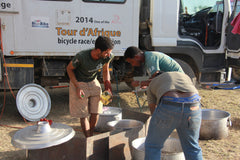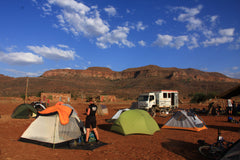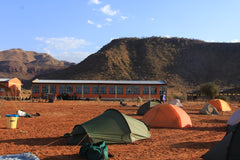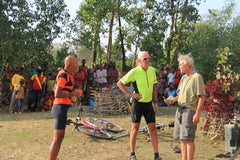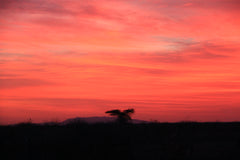News
Malawi Gin- Mbeya to Lilongwe April 23 2014
Throughout our journey border towns are always interesting experiences. There are herds of men trying to persuade you to exchange currencies, people selling drinks and food, and of course tons of buses traveling between countries. As a cyclist you can get confused in the process. Which buildings you need to go in to get an exit stamp and then where you need to go in order to get a visa. In Malawi the confusion was no different; men, women, children and foreigners in bike shorts and helmets entered into Malawi immigration. Some people had no shoes or shirts and were dancing in immigration to the great music that was playing! Welcome to the Malawi Gin section of the TDA.
Our first stop was at Chitmba beach on Lake Malawi! The beauty of this lake was incredible, surrounded by lush green hills and fishing villages. The campsite we stayed at was right on the beach. It felt so nice to have my feet in beach sand and go for a quick dip in the lake.
Some of the great sights we saw in this section were many local cyclists. They carried lots of produce on the back rack of their bikes. Whether it was livestock: goats, chickens, a pig, or local produce: tomatoes, lettuce, squash or maize bikes were loaded and often too heavy to ride. Local riders would whizzed passed us in full sprint on their single speed Phoenix bikes! At times, the riders would also draft off us in order to get more speed.
One of the other sights I witnessed along the roads in Malawi was a lot of agricultural fields. Many families are earning a living selling their produce at local markets. There is also a large timber industry and lots of deforestation occurring. Many men are seen in the distance cutting down trees and women are moving the extremely huge logs on their heads, from where they have been cut into piles that are then loaded onto trucks.
I also saw signs for international development agencies helping different towns and villages in Malawi. One of the projects seen frequently was promoting the end of human defecation in villages. Signs were created to identify villages that were “Open Defecation Free Area”. Not sure what the opposite of this sign would read? We found there was a cultural of shaming people who use the bush for a toilet. Children and adults made lot of noise when they saw foreigners or anyone else headed to squat in the woods. Clearly this made some of our camping areas a bit challenging when one needed to pee and there were no toilets to be seen, just a lot of children in view!
I also saw lots of friendly, curious children in Malawi. They would often say hello, but the translation in Chichewa sounds very similar to Money, which is still a soft spot for TDA riders, after the experiences in Ethiopia. Many times as we were parked on the side of the road trying to change tires or have a rest, children came in herds towards us shouting Munzgo! As in many other countries, on the tour, children love to come stand by the campsite and watch what the riders are up to. One morning outside of Lilongwe the children were up waiting around our tents at 5:30am.
Personally this section was a noteworthy experience of excitement to meet my boyfriend Justin in Lilongwe, but it also meant I was going to lose my riding partner Mateo. I had arranged with one of the restaurants in Lilongwe to have a table ready for about 25 people in order to have a farewell party for Mateo. However, there were over 39 riders who showed up and the manger, a 60+-year-old British man, was run off his feet! The food and company was terrific!
Leaving Lilongwe with Justin riding with me was amazing! Being born in Lilongwe meant that it was extra special for him. Even though our first day on the bike he had 5 flats and we crossed into the Zambia. This was the start of the Zambiez Zone of the tour! Another country under our belts also means we are quickly encroaching onto the last few sections of the tour. I cannot believe how fast time has flown by.
Massi Steppe- Nairobi to Mbeya April 09 2014
After I left my sister, Bella and Kaaya outside Arusha, the rain continued for two days as we headed into the off road section of the Massi Steppe. Despite the very quick downpour, it was a beautiful two days biking out of Arusha headed to the dirt road, which lead us to Mbeya. These 7 days were the longest section of our tour without a rest day, and were forecasted to be rainy, wet and very muddy! I was ready for it with my mountain bike tires and love of off road!
To my surprise, once we hit dirt my speed increased from 25km per hour to 30km. Clearly my motivation had picked up. Our first night in an off road camp was great; the campsite had bucket showers for us to wash off the days sweat and dirt. Over the next five days we had a little bit of rain in the night, but nothing significant until the last two days.
For me, the biggest event of this section was at a school camp where I decided to pitch my tent by a big tree. A few of the other riders, Steve, Kim and Mateo followed suit. As darkness set, we looked at the rings and three moons of Saturn on a rider’s telescope. Getting ready for bed, I brushed my teeth under the tree; quickly I realized that there were ants, big red ants, crawling all over my feet and legs. Looking down it was obvious I was brushing my teeth on an ant’s nest. Running away screaming for help, I found Steve who just laughed at me and did not think my yelling was really quite necessary. Ok, perhaps, yes, I was over reacting but I had never had anything like this happen to be before! Dragging Mateo with me, I walked back over to where the ants were and showed him that in fact that ground was moving, there were millions if not trillions of huge ants under the tree I pitched my tent. Mateo, also did not seem too concerned, and went into his tent for the night, mocking me. Within a few seconds he started to say there were ants trying to invade his tent; since he is really quite a jokester, I did not believe him. This was until I looked outside my tent and there were hundreds of ants crawling on my ground sheet and up the seams of my tent. Quickly we decided to evacuate that area, leaving Steve and Kim behind to fend for themselves. Yelling, laughing and dragging our tents away from the ant’s nest we went. Although we were safe from the ant nest, we were not able to escape the village disco that was pumping music as loud as it could! Oh camping, I really do not think I will camp much more in my life!
The day before we reached Mbeya many riders got caught in a huge storm that transformed our school campsite into a pool of mud. Riders who reached camp before the storm were able to set up their tents on semi dry ground, but as the rain heaved down, trenches were built around tents in order to prevent a flood inside their tents. The next day we knew there was going to be a lot of mud for us to bike through, so I was excited, but we also knew there was a huge climb into Mbeya, through an area called the “Worlds End” and that there was a good chance it was off road.
World's End
Having the mental challenge of ant attack under my belt, I knew I was ready for unknown road ahead. Around 40km we hit pavement and by about 60 we hit road construction. Views from the “World’s End” were like nothing I have ever witnessed before! Low lying clouds looked as though they were touching the road ahead. From the high elevation we could see far off into the distance, and it really did feel like a scene from The Lord of the Rings. It also became very stormy and rain came down on us like nails. The pelts hurt my skin and eventually I became very cold. Continuing to climb into the abbess, it became colder as the rain continued. Eventually we reached the top of the climb and needed to head downhill on this horrible, pot whole filled road, with humongous rain filled potholes. I could not feel my feet, or my hands, and was worried about the state of my break pads. Mateo, being the smarter of the two of us, decided to put his bike in a dump truck and meet me at the bottom of the hill. Clearly I made it down the hill; arriving to Mbeya, drenched, frozen and feeling exhilarated that we had competed another section of the TDA 2014.
Mateo and I after biking up and over the "Worlds End"
Meltdown Madness - Nairobi to Arusha (Too slow for photos day) March 25 2014
This section of our tour seemed to whizz passed us in comparison to a month in Ethiopia. We crossed the border from Moyale, Ethiopia into Moyale, Kenya. In this area there is often disputes between the two places as they fight over the border limits. Several times on past TDA expeditions riders have not been able to ride in this area due to the conflict. By scouting ahead of the riders, our tour director was given the all clear from local authorities that we were safe to cycle. Upon arriving in Kenya we also picked up three security guards due to nomads who are on the look out for tourists and their possessions. We had absolutely no problems crossing through Northern Kenya; accept for the horrendous road conditions!
The name of this section of the tour is called Meltdown Madness. After the roads in Ethiopia, I was not sure how the bumps could get any worse, but I was quickly proven wrong as we started to cross through the Dida Galgalu lava rock desert. Huge rocks were scattered all over the dirt path. We also encountered a far bit of road construction; within the not so distance future this section of the tour might need to find a new name! I cannot imagine several years ago when all of the kilometers would have been on the bumpy old dirt trails through northern Kenya.
Masai herders and their families inhabited most of this area. Lots of beautifully beaded men, women and children were seen along the road. Arriving in a town called Marsabit (said to resemble Mars) there were also lots of Somali tribes at the local market.
As we headed further south and the desert began to disappear our campsites began to greatly improve. Leaving behind lots of sand in dirt we were able to shower in lodges that were equipped to handle over land tourists. Trust me, it is a real novelty to have a cold bottle of water or juice after a long day on the bike, a cold shower was really something. Until this point of the tour showering was really only available on rest days. Due to the vast amount of tourism in Kenya, there are a lot more facilities available- I might even call them luxurious in comparison to the bush camps we slept at throughout Ethiopia.
We convoyed into Nairobi, which was also quick interesting. The traffic in this city is crazy, so I took my chances and volunteered to help patrol traffic, which means stopping cars that try to cut off our 35-person bike convoy. A bit of a dangerous position at times, but helped to keep me occupied. Sitting in traffic is never fun, but in stopping traffic I am able to talk and wave to locals. It was great to spend some time in Nairobi visiting with friends and going on a tour of Kibera, a slum with over 1 million people.
Two days out of Kenya we crossed the border into Tanzania and travelled into Arusha where I met my sister and was able to visit Peace Matunda! The children at the orphanage and school have grown since I was there in 2011, but they are still as precious as ever. It was great to meet with Kaaya and Jackie in order to discuss future plans for December 2014 when the children will attend Secondary School. We determined that it would cost about 1100USD the first year and about 700USD for the next three years of the children’s secondary school. Thus, the goal of 12,000USD that I want to raise while on the tour will help four children attend secondary school. In Tanzania the Standard 7 students write standardized exams and then need to apply to three high schools.. The government determines where the children are sent to secondary school, and offers scholarships to students who achieve high results. There is the potential for some of the Peace Matunda children to receive scholarships. The student who I am currently working on sponsoring is Jennifer Charles. Jennifer lives in a small house with her grandparents and her younger brother, Ibrahim. Jennifer’s parents abandoned the children shortly after Ibrahim was born. The NIST community has supported Jennifer’s family since our visit in 2011 so I am very happy that we will be able to continue to support Jennifer into the next stage of her life. While chatting with Kaaya and Jackie, it became very clear that there are a lot of students at Peace Matunda who have a similar situation to Jennifer. In trying to raise 12,000USD I hope to send four students to secondary school for four years.
Biking out of Arusha was really special for me. Kaaya the founder of Peace Matunda, decided to join me along with his cousin and my dear friend Bella Six. Also along for the ride was my amazing sister, Kayleigh. It was wonderful to bike along side these three very special people! Kayleigh and Kaaya were able to bike 35km outside Arusha before taking a bus back to Peace Matunda. Bella Six continued with me to lunch at 65km, when in started to torrential down pour, he decided to also head back home!
After Arusha we headed off road through Tanzania. I will write a separate blog post for out amazing mountain biking; 7 day off road days into Mbeya, Tanzania.
A day in the life of a TDA rider March 09 2014
We have been on the Tour D’Afrique for a almost two months and I am very much adjusted to life as a cycle tourist. In fact, many of the strange nuances of being a rider now seem very normal and I wanted to share some of my daily activities.

5:45am- Wake up to the sound of tents being folded down, and people headed off to either our brown unisex “toilet tent” or the closest bush that is 100meteres away from the tent area. The tour has supplied lots of shovels for digging holes and many riders have also brought their own! I had read lots about the details people shared regarding their bowel movements and never really expected to listen to as many conversations on this topic.
6:00am- The official wake up, a car honk, by one of the TDA staff. Meanwhile our amazing cook as has started breakfast, consisting of either oatmeal or granola accompanied by bread or chapattis and a variety of spreads: nutella, peanut butter, jam, honey, corn syrup, and butter. Of course several bananas are cut up and put into our breakfast to help with muscle recovery! Also at this time many riders are enjoying their morning tea and coffee awake up. Personally, in the darkness of my tent, with only the light of my dying head torch battery, I am trying to find all of the requirements for my ride: bike shorts, a shirt, leg and arm sun protectors, sunglasses, shoes, socks, helmet, GPS, GO Pro, iphone, ear plugs, camo back, butt cream, first aid kit and my race chip, thank goodness I am a morning person otherwise I really would struggle to get ready on time!
6:30am- By now I have packed up my tent and sleeping gear, taken my malaria and am off to start my morning work out-shoving all my stuff into a small locker made out of wood. As I lug all my stuff over to the truck, I am secretly hoping that the riders around my locker have already packed up their belongings; it is quite cramped in the truck as everyone gets ready in the morning. Breakfast is devoured as soon as my locker has been jammed shut.
7:00am- Official departure time. Many riders have clocked out with their timing chip and started peddling! The first person to leave is often Erwin, a middle aged German man. The rest of the riders trickle out to begin their ride. This is also the time when you question your clothing choice for the day. Weather on the tour is varying. Sometimes I wake up just about froze and know that I will need extra layers for the morning, other times, it is hot at 7:00am and I know putting on copious amounts of sunscreen in the darkness might turn out to be a sun burn disaster. Since I have signed up for the race component of the tour, I need to remember to clock out when I leave in the morning. I often remember that I did not lock out five kilometers down the road! As part of the race, we have “Mando days” which means that all riders who want to race need to start at 7:15. On these days, time bonuses are given out: 30 minutes for 1st place, 20 minutes for 2end and 10 minutes for 3rd place. These bonuses are given to both men and women and the bonus is taken off their daily time. Although I enjoy taking part in the race, my biggest competitor is myself, as I can be my own worst enemy.
7:30am to 10:30am- Between this time my riding buddy Mato and I have passed amazing scenery, whether it is mountain vistas, sand dunes, unpaved lava rocks, desert terrain or ordinary tarmac many laughs have been shared. Although Mato, and I are on the same bike trip we often see things that each other completely misses. As a result, we often ask each other if we are on the same tour! Depending on how long the ride is, our favor snack of a PBM bar will be demolished in order to have more power to get over the hunger until lunch. I will often go through at least three liters of water in my camo back and sometimes need my water bottle in order to reach lunch well hydrated.
10:30am to 12:30pm- Although this time depends entirely on how long the ride is, we will hit the lunch truck, aka Steven’s Diner. Steven is our very friendly Tanzanian lunch cook. He always has a variety of options for us to eat. Fruits like: watermelon, banana, pineapple, apple, mango, papaya, whatever the local farmers have harvested. Tuna, avocado, egg, ham, cheese and spam are often the items we have to make sandwiches. Also on offer is any left overs from the previous nights dinner. Although there are not many rules on the TDA, one of the main rules about the lunch truck is you MUST wash your hands before going anywhere near the food and need to be considerate that you do not each too much in order to leave some for other riders who are behind. Our tour director has told us horror stories of previous years when the last riders, whom have been the longest since breakfast, would arrive at the lunch with barely even a rotten banana to get them through until they reached camp. Before taking off for the last half of the ride, I will re-fill my camo back and water bottle- the last experience I want is to run out of water when there are no shops along the way.
12:30pm to 5:00pm- Again, depending on the length of the days ride my arrival to camp will vary. However, once I reach the campsite for the night, my first rule of business is to get out of my bike shorts. I despise wearing them any longer than absolutely possible. I will then unpack my locker and with the help of Mato, put up my tent. Using the ever so handy baby wipes, I will attempt to get some of the rides dirt off my face and legs, but honestly the dirt really does not come off until I shower in anywhere from one to five days later. After locking up my bike and getting my tent organized, so there is a place for my to sleep, I will have some of the wonderful soup that our cook has made and re-hydrate for the next day’s ride. Many conversations can be heard about the days events: what riders saw and experienced, their health and digestive issues, order of arrival to camp, road conditions, average speed, problems with their bikes ect, ect. When I have heard enough of the day’s analysis, which for me does not take long, I retreat to the shade if any can be found. Facilities at our camps are often very sparse; mostly we are sleeping in the middle of nowhere in a field. Our camping sites have ranged from abandon amusement parks, mountain peaks, cow field, convents, deserts, forests, schools, to actual camp sites with showers and toilets. Depending on where we camp, riders could go to a town and hunt for cold drinks and snacks. One time we found freshly made donuts and ordered 40 to bring back to the hungrycyclists. At times, some of the locals will know we have arrived to their territory and bring us hot to lukewarm drinks. In Ethiopia a barrier of string was put up around our campsite in order to prevent the ever so curious children and adults from entering our tents and to create some sort of boundary. This did mean that at times there was any where from fifty to two hundred people standing around the campsite watching our every movement. When we were told this would happened, I really thought it was a joke, boy was I wrong.
5:30 to 6:00- The daily sound of “Rider meeting” is summoned. But in reality this means people walk away to get their dishes for dinner and finish a few last minute things before sitting down to the instructions for the next days ride. Our tour director explains the turns and terrain challenges along with any points of interest, this includes coke stops and perhaps the one tree between the start and finish of the ride. Depending on where we are, the instructions will vary. When crossing Sudan we were given directions like, turn left at the jerry can, or right at the abandoned tire. In Ethiopia it was more direct- 50km there will be a village, with coke and children who are known to be vicious, so ride through with precaution. In most cases, we are riding on the same road for each section between rest days. As soon as the instructions are given, and the noises of peoples hunger have prevented questions dinner is served. Since I am eating vegetarian there is great local produce available for me to consume. We have had incredible pasta, beans, BBQ squash and a variety of different salads. As I wash my plates from dinner, the sun begins to set over the horizon and I am amazing a the colors the sky can create.
.
7:00pm- Is normally when I retire to my tent to write some notes in my journal and read a few pages of a book. Earplugs are inserted as I fall asleep to the sounds of donkey’s, dogs, chatter from the riders, and indefinable insects. I truly am loving my life as a TDA rider and am excited for the what the next few months will bring!
Ethiopia Update- Part two! March 03 2014
The “Biblical Ethiopia” section of the tour finished on the 27th of February. We have now begun the section called “Meltdown Madness.” The name was given due to the hard core off road this section has; biking through the Dida Galu Desert and the lava rocks that are remnants from a volcanic explosion several years ago. We will reach Nairobi on the 8th of March.
Reflections on “Biblical Ethiopia”
Due to the 81 million people that live in Ethiopia, I am sure the sounds are different then many other countries in the world. There are hundreds of people standing on the side of the road as we biked through their villages. People are generally excited to see cyclist’s whiz pass and often several locals, young and old, are yelling phrases. Some of the most popular are “Where you go?”, “You, You, You”, “Welcome to Ethiopia” then there are those phrases that really have wore on the riders, “Give me money”, “Give me pen”, “Give me bike”, Give me banana”. The constant shouts and screams heard along the way have been very exhausting for many TDA riders. There are different reactions; some riders have ridden with sticks for protection and intimidation, feeling that is their best defense against both the stones and yelling locals; others chose to totally ignore, not responding.
Personally, I have tried to respond with Salemo, (Hello) to anyone, young or small who is calling to get my attention. Although it does become exhausting I have been able to avoid any serious threats or stones hailed my way. I have been lucky to ride with a buddy: Mato, a fifty-year-old man from San Francisco. We have had each other’s backs throughout the passed thirty days riding through Ethiopia. Many laughs and stories have been shared.
Besides the chatter of people we have heard lots of birdcalls, as Ethiopia is home to several species of birds. Often we wake up and fall asleep to the chirpings of nature’s creatures: small sparrows, big vultures, and hornbills. Often we will hear barking dogs or donkeys in the distance!
Since we have spent almost a month in Ethiopia we have witnessed so many different landscapes and scenery. Starting off in Gondar, and traversing the Simien Mountains was mesmerizing. We probably have climbed well over 30,000 meters, both on and off road, and as a result have had incredible views.
Descending after a long climb is very rewarding, and is truly a mountain bikers dream come true. As I pealed down the mountain, I have been totally enthralled by the mountains and the potholes I need to avoid!
After leaving the Simien Mountain range, we descended into the Blue Nile Gorge and quickly proceeded to climb 20km out again. This day had a lot of build up on the tour, as it was both a time trial and one of the main highlights of the “Biblical Ethiopia” section.

As we ventured further south, the landscape changed again to lush green hills filled with local produce: wheat, mangos, banana’s, avocados and sugar cane. As we left the country, our landscape turned into red soil and termite hills, showing signs of entering the northern desert of Kenya.
We have also been very luckily to bike into some of the most historic towns of Ethiopia: Gondar, Axum, Yabello, and Debre Birhan. The ancient importance of these towns has been very interesting for a history buff like me!
Besides the sounds of the children of Ethiopia, the sight of many kids hurdled together was often quite intimidating. I really never knew exactly how they would respond to me. Some of the spectacles witnessed were children doing the Ethiopian shoulder dance in the middle of the road, waving and smiling, running along side your bike, picking up rocks, or just starting in your direction. As I passed the children I found myself turning around to wave Ciao and seen if there were any rocks headed in my direction. Sometimes there were, often times the kids headed in the direction of the next cyclist.
In the rural environment, young children often were dressed in rags and many small boys were naked from the waste down. The reality is that many of these children do not attend school. They are helping out the family by herding the livestock or carrying loads of sugar cane or firewood on their backs and heads. Passing by small children who were carrying water from the community well to their homes was a common occurrence. I often would see people walking from what looked like nowhere towards a vista that also looked like nowhere. As much as there were a lot of people in the villages we passed there was still a lot of open landscapes where no houses were in sight, but many people still roamed.

The local ingera, in small qualities, with chick pea bean curd or different types of meats had been enjoyed and thrown up by many riders. Clearly, Ethiopia has some bacteria that our tummies are not use to, thus over the course of the passed few weeks, almost every person on the tour has had an upset stomach.
It is amazing how much my butt has been able to withstand long hours on the bike. Each day we were riding between 4 and 8 hours, often only getting off the seat to eat lunch and run to the washroom in the bush! Although there were days when I was tried, I have truly enjoyed each day on my bike and love that I have the opportunity to have visited Ethiopia on two wheels.
Biblical Ethiopia February 09 2014
Since our arrival in Ethiopia, on the 31 of January, it feels as though we have peddled over all the mountains this country has to offer! We crossed the border from Sudan into Mettema, Ethiopia and have been climbing the Simien Mountains, mostly off road, ever since! The views, although endless, are truly breathtaking.
There are around 91 million people in Ethiopia, so the villages we have biked through are packed with people. Often the locals are not watching closely for a stream of bikers to wiz through their ever-so quite village, so are not paying attention to where they are walking, thus riding with extreme precaution is very important.
The young children of Ethiopia, although very cute and generally smiling and welcoming, do love to throw rocks. It seems it is part of Ethiopian culture to partake in the activity. When the adults scold the children for throwing rocks, the punishment given is identical- rocks are pitched in the direction of the youngsters. Each rider has their own philosophy on how to deal with the children: ignore, yell, wave, talk, or cheer as they peddle passed.
Personally I have the approach to talk, wave and cheer at the children as I am approaching. I do my best to say Hello in Amheric, and have had some delightful conversations with children as they attempt to run along beside my bike. However, it is intimidating to approach a group of small, seemingly innocent kids, and have no idea how they are going to react. I have taken the tours advice and tried my best to ride with a buddy, which often does help, not protect you from the children, but be an extra target in the village!
We have been luckily to visit some of the most historical areas of Ethiopia: Gondar, Axum, and Lailbela. The Coptic Christian influence is amazing, and history behind the churches is really quite impressive. From the Debre Birhan Selassie to the rock cut churches I feel really luckily to be able to ride into these historical cities.
We have over 15 days left in Ethiopia, and I am excited for what is to come!
Pyramids of Nubia- My Sudanese Experience January 30 2014
We have completed the first section of the 2014 Tour D'Afrique through Sudan. Named the "Pyramids of Nubia" due to the historical landscapes we road passed. I have decided to break down the countries we visit into the 5 senses; sights, sounds, smells, touch and tastes, and perhaps a random category for other interesting experiences that have occurred.

The sights of Sudan have been magnificent. From amazing sunsets to camels touring through the desert, we have been exposed to a part of this country that many tourists have never seen, and many Sudanese people have never travelled through. Each morning begins with darkness, surrounded by more starts then I thought possible in the universe. Often riders do not even need their head torch when in search of a nighttime bathroom run.
One of the best memoires I will have of this section of the tour was taking off on my bike just as the sun peaks on the horizon and continues its journey, rising above me. Riding in the deserts of Sudan, there are no building in sight, nothing blocking your view of this daily, but amazing occurrence on earth. As we ride along the road many buses wiz passed us headed for the next town, anywhere from 400 to 10km from away.
Frequently we will see camels in the distance. It is a beautiful sight to see a Sudanese man riding on a camel, wrapped in a white dress, with a bright turban on his head. At times we have seen small villages with children close to the road waving and looking at us with questioning eyes, wondering what on earth we are doing. Once we arrive in a city, the organized ciaos begins, tuk tuks, donkeys, horses, motorbikes, cars, trucks, buses, and people are within feet of our bike tires. To date no one has hit anything, but we have over 100 days to go! Our campsites are generally outside of towns or cities in order to have a bit of privacy and silence. Once it is realized that camp is within site you begin searching the horizon for it, hoping over the next hill the alien looking settlement is to be found. Our camp equipment consists of two big trucks, a land rover, an SUV, over 30 tents and a just as many bicycles. Hence the reference to an alien landing, we are a strange site in the middle of the desert landscape, perhaps even a mirage to some.
As the sun sets over camp, we are all exhausted after an amazing but challenging day of sand and wind, or both. Despite this feeling amongst most riders, we are all able to marvel at the magnificent African sun, setting right before our eyes. The colors of the sky are like I have only ever seen on Nat Geo or in photo competitions, but for us they are a reality, and they will continue to amaze me throughout this journey.
Sudan is a predominantly Muslim country, thus they take part in a call to prayer three times a day. Whenever we are staying close or nearby a town that is our morning wake up call. In Khartoum, the sound of the prayer call was a thrilling experience and a beautiful way to wake up. After two weeks, I am excited to hear the sounds of the morning wake up in Ethiopia.
While riding the sound of horns beeping and buses driving by are helpful but also make you jump in fright as they wized passed at record speed. Although much of Africa has a reputation for being slow, my feeling is that the buses must be on time given the speed at which they travel. When arriving at the half waypoint of our ride, we will come across the awaited lunch truck with Steven, a kindhearted Tanzanian man, ready for the hungry tigers to attack. He will have African music playing out of small speakers, which gets our heads out of the road, and back to the reality that we are in Africa.
At times I embrace the natural sounds while riding, the wiz of my tires as they spin down the road or through sand. However, I really enjoy getting lost in my African beats. I have waited for the moment when I biking that these special songs will be playing in my ears as motivation to keep peddling. I often will cheer when one of my favorite songs comes on and will attempt to sign along. For those of you who have heard me sing, you will know I should be doing this is alone!
At varying times throughout the afternoon, riders will get to camp and the chatter of people talking about their experience, how they felt at certain points of the day, who they road with and what type of noises their bikes are making is endless. Once the sun goes down, so do the campers. The silence of the night is often tremendous, except when the dogs are barking or cars drive by and honk at our alien settlement. Often in the middle of nowhere, we enjoy the sound of the nothingness that surrounds us.
The lingering smell of a dead animal is like nothing I have ever experienced before. Whether it is a camel, goat, donkey, dog, or fox, the stench is worse then the oldest rotten egg you have ever smelt. Depending on where we are riding road kill will vary. After being in the desert for six days, with little to look at or smell, the scent of the freshly squashed dead animals, was outrageous. We eventually realized that these poor animals were headed to the local Saturday animal market and their herders would most likely be devastated by their death, as it meant a reduction in the price of their herd.
The Sudanese cities, we have ridden through, have similar smells of all developing cities: exhausted fumes, open sewers, dust, and garbage pits. But they do have an amazing waft of freshly fried falafel, kebabs, and donuts- our staple local foods while here in Sudan.
Although a terrific feeling for the first hour of your day on the bike, your handle bars often will become very tiresome to touch. At varying points, your hands go numb and start to throb, wondering why on earth they have been in the same position for hours on end. The visible dirt that you pick up on your fingers within a short time while camping is astounding. What is more worrisome is the dirt you do not see. Many people on the trip so far have already begun to suffer from gastrointestinal issues and colds. No matter how much you wash your hands, it seems you cannot get all the dirt and bacteria off. Especially when an endless supply of soap and water is really not available. I do love to get my hands dirty cleaning my bike and working off some of the day’s dirt, but it does become a hassle trying to scrub off the dirt.
Despite the limits on our resources in terms of cooking equipment and food options, our cook has created some of most amazing meals on this trip that I have certainly ever had while camping. Marconi and cheese, bread pudding, grilled eggplant, bean stuffing, are just a few of the wonderful meals our cook has prepared, all by hand, on a open fire and in huge cooking pots! Breakfast normally consists of oatmeal/cereal, bread with nutella, peanut butter, and bananas. A mid morning snack will be a PBM bar, a protein bar of sorts, that certainty does give you enough energy to make it to the lunch truck, where fresh fruits, sandwiches and the night before left overs are up for grabs. When we arrive at camp we have fresh soup waiting for us as a post work out snack. In terms of local food, falafel has been my staple food while on rest days. The other food option is fool, a local bean stew that is also quite good and does give some protein.
Overall, I have been impressed by the kindness of many of the local Sudanese people we have come across. Often times they welcome you to Sudan, and want to know where you are from and why you are visiting their country. It is hard to explain that we are biking to South Africa, and when that is understood, they clearly do think we are crazy.
Some men and young boys have been quite rude at times and have touched and grabbed at some of the female riders when they are travelling alone. Often when walking with a man the Sudanese males will leave you alone, but when walking as a female, without a male companion you do get several shouts, whistles and kissing sounds. It is definitely advisable for women to dress very modest and cover up shoulders, knees and more. Women here are all in a headdress and sometimes a total hijab. Men wear long white shirts and turbans, and schoolboys and girls roam around in what looks to be pj’s from the 1980’s.
The houses in the city are made with cement, while on the outskirts of town they are made with mud, or cloth. There have been some small camps, totally in the middle of nowhere, where Saudi herders live in tent camps. In the desert these people are very far away from a water source and food. So I am not sure how they survive. In other villages, near a water source, they are much better off, as they can grow vegetables and often will have herds of animals as their main assets. These houses are still made out of mud from the water cannels and people are not prosperous by “our” definition.
Nonetheless, people regardless of their possessions do seem happy and without the mass consumerism and commercialization it seems they do not really know what they are missing. There has been very little tourism in Sudan, which for me means that foreigners and their gadgets have not tainted the locals view of what they “need” in life. Most towns are still very market based and have a few shops with electricity for water and cold drinks. There are a few phone stores, but only in Khartoum did we see cameras available to purchase.
It seems fascinating that depending on what country you are born into your options and opportunities are so far apart. In Sudan, from what I have seen your options are not very vast. I have had conversations with a few men who really want to leave Sudan and many young men who are really unhappy with their country, and government. They will ask, “What do you think of Sudan?” Often our response is very PC and we will say, “Beautiful, and people are very nice” They will response by, “No. Government not good” and, “People are poor”.
I have also been surprised how many people speak English and want to share with you what they know!
Biking through Sudan has been a wonderful glimpse into the parts of Africa that we are going to witness. Areas of the world that are often not your normal tour through the African savanna. I am excited for what Ethiopia will bring!
Khartoum to Cape Town Briefing Highlights! January 08 2014
dddArrived in Khartoum January 07 2014
Well, the journey has officially began. The days leading up to the departure were filled with making lists for last minute items and getting four months worth of gear into three bags. Eventually everything was all packed and ready to go; off we headed to the airport!
After waiting for an hour or so in the Ethiopian airline line, we realized that the plane had been over booked and there was no way I was going to be flying out. I found an Ethiopian airline flight attendant who was able to get me onto a Qatar airways flight departing at 830am the next morning.
Back home we went so I could rest for a few hours and then head back to Suvarnabhumi for the new flight to Khartoum. Not knowing that the baggage allowance was less on the Qatar flight than the Ethiopian flight I was dinged with an over baggage fee of 350 dollars.
I arrived in Khartoum without any further issues and have put by bike back together, it is ready for the trip! Many of the riders have arrived and are putting together their bikes before we head out!
I am so happy to be back in Africa! The past two days have been spent touring around Khartoum. The people here are so friendly and always up for a chat. One of the main questions from the Sudanese has been, "Why you are visiting Sudan?". When I have explained that I will be biking to Cape Town, they really look at me strangely and ask, "Are you crazy lady".My response has been to smile and nod. I am sure this conversation will happen several times over the next for months.
We start biking on Friday morning, not sure to where or how far, but I am pumped to get on my bike and get started!
Below are a few photos of the tour we did around Khartoum.

Snake skin and a baby crocodile at the marketin Khartoum. Thought about buying them as mascots, but then realized any item I purchase will need to stay with me until Cape Town. The reptile skins well not make the cut.

Sudan is a lot bigger than I thought! We will spend three weeks biking to the Ethiopian border.

Nubian temples that have been excavated in put into a museum in Khartoum. Many of the other foreigners in Sudan are archeologists working on excavation sites around the country.
XXSome much-deserved thanks... December 31 2013
As this year comes to a close, there are a few people who volunteered their time and expertise to Peace by Piece. We are beyond grateful for all of their support as they have helped us tremendously along the way...
LHWH Advertising in Myrtle Beach, SC volunteered their time and expertise to design our wonderful website! We love the end product and would highly recommend their services!! Thank you!! http://www.lhwhadvertising.com
David Smith Associates spent many patient hours helping to keep our books in order and filing our taxes and we are so appreciative of their time and help! http://www.davidsmithassociates.com
Studio 303 Inc. designed our fantastic logo, on which we get complimented all the time. Thank you!! http://www.studio303inc.com
We are also grateful for Color Incorporated ProPhotoLab for their assistance with printing photos for our recent fundraiser- check them out! http://www.colorincprolab.com
2014 promises to be a big year for Peace by Piece as we plan to build a dormitory and begin funding school scholarships for the 2015 school year. Thank YOU ALL for helping us to reach these goals!!
Peace and love,
Susan

A successful fundraiser! December 18 2013
Thank you to all who attended our fundraiser in Atlanta on November 23rd, 2013! And huge thanks to our hosts, the Bender family, who graciously opened their home and hosted a fantastic event! We raised over $10,000 towards the dormitory construction, bringing our total to $35,000 thus far. We hope to break ground in the near future. Our goal is to have the dorm complete by the end of 2014, ready for its first residents in 2015, when we will start providing secondary school scholarships for the kids. We only have $10,000 more to go to put a roof over these kids heads and furnish the dorm. Holiday gift anyone...? :)











Meet Jennilea... December 03 2013
I want to introduce Jennilea Hortop, one incredible, adventurous, and caring chick. She too, fell for the amazing kids at Peace Matunda Orphanage and wants only the best for their future. Jennilea is about to embark on the journey of a lifetime- all for a great cause. This is from Jennilea- she will be posting about her adventures along the way on this blog and on the PbP facebook page. ~Susan

From Jennilea:
Thinking about Africa gives me goose bumps of excitement and a longing for adventure. In two months time, I will be in Khartoum Sudan embarking on what I know will be some of the most amazing experiences of my life. Riding 12,000km, in 120 days, through 10 countries I will join fifty other riders from around the world, as we travel by bicycle from the North to the South of Africa.
While on this journey I plan to help a cause that is very close to my heart, Peace Matunda Orphanage and School. I first came to know Peace Matunda in June 2009 when my friend, Sarah Patriquin, and sister, Kayleigh Hortop, headed to Arusha to meet twenty-one young Tanzanian children. We immediately fell deeply in love with the children who lived and attended school at Peace Matunda. Living for six weeks in the foothills of Mount Meru, was a life changing experience and I knew that I would be back to this magical place.
In 2010, I traveled with a group of eight high school students from NIST International School in Bangkok, Thailand to share this special community. The students helped to develop some of the projects that the director of the organization, Kaaya Unambwe, was working on at the time; a new school building for Standard Five and Six, and a lunch program for all students at Peace Matunda. In both 2011 and 2012 more NIST students traveled back to Tanzania to learn from the amazing children at Peace Matunda and the surrounding community. Again in April 2013, 12 more students and teachers will travel to the foothills of Mount Meru to spend time learning about Tanzania culture and visiting the orphanage.
After four years of watching the small children of Peace Matunda grow up, they are ready for the next step in their lives; secondary school. In collaboration with Peace by Piece I plan to help provide the children of Peace Matunda with a secondary school education. My goal is to raise 1 USD for each kilometer that I will bike through Africa to help sponsor these children to have a secondary education. On the Peace by Piece donor page, the are many options for how you can donate to Peace Matuada, specifically there are links that say "Donate for education" please select the amount you would like to help to provide these beautiful kids an education.
On the Peace by Piece Facebook page, I will be updating my bike journey through Africa; If you haven't already please like this page so you can follow my story.
Jennilea
How Poor We Really Are August 02 2013
One day a wealthy family man took his son on a trip to the country so he could have his son see how poor people could be. They stayed one day and one night in the farmhouse of a very humble farm. On the way back home at the end of the trip the father asked the son, 'What did you think of the trip?'
The son replied, 'Very nice, Dad.'
The father then asked, 'Did you notice how poor they were?'
The son replied, 'Yes, I guess so.'
The father then added, 'And what did you learn?'
To this question, the son thought for a moment and answered slowly, 'I learned that we have one dog in the house and they have four. We have a fountain in the garden and they have a stream that has no end.
'We have fancy lanterns in our garden, while they have the stars. Our garden goes to the edge of our yard, but for their back yard they have the entire horizon!' At the end of the son's reply, the rich father was speechless. His son then added: 'Thanks, Dad, for showing me how poor we really are.'
~Author Unknown~
Did you know... June 02 2012
-89% of the population of Tanzania lives below the international poverty line of US $1.25 per day 1
-While 71-75% of Tanzanian children attend primary school, only 8% continue on to secondary school 1
-26% of children in Tanzania, under the age of five, sleep under an insecticide-treated mosquito net 1
-There are 3,000,000 orphans in Tanzania, ages 0-17, 1,300,000 orphans due to the AIDS crisis 2
-A Tanzanian with primary school education earns 75% more than one with no schooling. A secondary school graduate earns up to 163% more. 3
-Fertility rates in Tanzania for females aged 15-40 years: with no formal education: 6.9 births per woman, with primary education: 5.6 births, and with secondary and higher education: 3.2 births 4
1 UNICEF: State of the World’s Children report 2011
2 UNAIDS, Report on the Global AIDS Epidemic, 2010
3 Post-Basic Education and Poverty in Tanzania, Ruth Wegwood, July 2005, based on information from World Bank 2004/Integrated Labour Force Survey
4 The United Republic of Tanzania, National Population Policy, Ministry of Planning, Economy and Empowerment, 2006
- Previous
- Page 2 of 2
